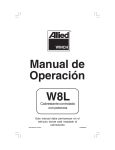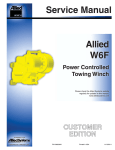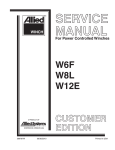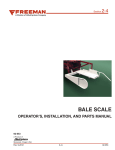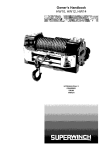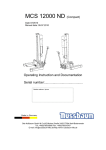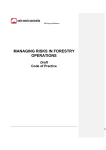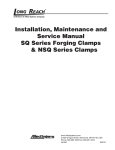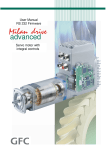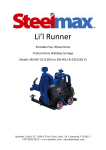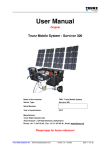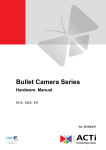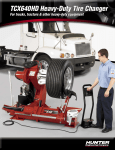Download 599030W - Allied Systems Company
Transcript
This manual must be with the vehicle on which this winch is installed. Please check the Allied Systems website regularly for updates to this manual. www.alliedsystems.com P/N 599030W 08/12/2010 Winch Model Date Delivered W5B Serial Number Date Installed Special Equipment or Attachments A Product of Allied Systems Company Sherwood, Oregon USA 08/12/2010 Printed in USA Foreword Foreword The safe and efficient operation of a winch requires skill and alertness on the part of the operator. To develop the skills required, the operator must: • • • • Receive training in the proper operation of the winch and the machine on which it is mounted. Understand the capabilities and limitations of the winch and the machine on which it is mounted. Become familiar with the winch and the machine on which it is mounted and see that they are maintained in good condition. Read and understand the SAFETY SUMMARY and OPERATING PROCEDURES contained in this Operating Manual. In addition, a qualified person experienced in the operation of the winch must guide a new operator through several load handling applications before the new operator attempts to operate the equipment alone. It is the employer’s responsibility to make sure that the operator can see, hear, and has the physical and mental ability to operate the equipment safely. This Operating Manual contains basic information necessary for the operation and maintenance of a winch. Optional equipment is sometimes installed that can change the characteristics described in this manual. Make sure the necessary instructions are available and understood before operating the winch. Some of the components described in this Operating Manual will NOT be installed on your winch. If you have questions about any item on your winch or described in this Operating Manual, contact your local winch dealer, or contact Allied Systems Company: Allied Systems Company 21433 SW Oregon Street Sherwood, OR 97140 USA Phone: 503-625-2560 Fax: 503-625-7269 E-Mail: [email protected] Also visit our website, www.alliedsystems.com, where the most current copy of this manual is always available. i NOTE: For repairs and overhaul, contact your Allied winch dealer. If you maintain your own equipment, a service manual is available for your specific winch. ii NOTE: This publication may be translated to different languages for sole purpose of easy reference in non-English speaking locations. Should there be differences in interpretations to the text, please refer to the English language edition published by Allied Systems Company as the controlling document. Contents Contents Foreword .................................................................. i Contents ................................................................. iii Safety Summary .................................................... V General Introduction ...............................................................1 How The Winch Operates .........................................1 W5B Winch Description ............................................3 Nameplate ................................................................5 Wire Rope Selection .................................................6 Oil Capacity & Recommended Oil List .....................7 Optional Equipment ..................................................8 Serial Number Codes ...............................................9 Tractor & Skidder Identification Codes .............10 Operation Checks Before Operation .......................................13 Checks During Operation .......................................13 Operating Procedures ............................................14 Power Operation .....................................................16 FREESPOOL Operation .........................................18 FREESPOOL Adjustment.......................................18 Troubleshooting Chart ............................................20 Maintenance Maintenance Points ..........................................31 Maintenance Schedule ....................................32 Control Cable Adjustment.......................................33 Operating Techniques Tractor or Skidder Operation ..................................37 How To Move A Disabled Vehicle............................40 Working on A Steep Slope .....................................42 Tractor Is Down The Slope ...............................42 Other Equipment Is Down The Slope ...............43 Operational Differences, Optional Equipment Integral Arch ...........................................................45 Fairlead ...................................................................45 Drawbar ..................................................................46 Optional Gear Ratios ..............................................46 iii Intentionally Blank iv Safety Summary Safety Summary General Safety Notices The following pages contain general safety warnings which supplement specific warnings and cautions appearing elsewhere in this manual. All electrical and hydraulic equipment is dangerous. You must thoroughly review and understand the Safety Summary before attempting to operate, troubleshoot or service this winch. The “WARNING” symbol appears wherever incorrect operating procedures or practices could cause serious injury or death. Carefully read the message that follows to prevent serious injury or death. The following symbols/terms are used to emphasize safety precautions and notices in this manual: DANGER The “DANGER” symbol indicates a hazardous situation which, if not avoided, will result in death or serious injury. Carefully read the message that follows to prevent serious injury or death. The “CAUTION” symbol appears where a hazardous situation which, if not avoided, could result in minor to moderate injury and equipment damage. v This signal word alerts to a situation that is not related to personal injury but may cause equipment damage. NOTE: … The term “NOTE” highlights operating procedures or practices that may improve equipment reliability and/or personnel performance. Should the recommendations in this manual deviate from those in the user’ country, the national regulations should be followed. NOTE: All possible safety hazards cannot be foreseen so as to be included in this manual. Therefore, you must always be alert to potential hazards that could endanger personnel and/or damage the equipment. The winch shall not be used for hoisting. Safety Regulations Each country has its own safety legislation. It is in the operator’s own interest to be conversant with these regulations and to comply with them in full. This also applies to local bylaws and regulations in force on a particular worksite. vi Use hearing protection when operating winches. Safety Summary Operation, Inspection, and Maintenance Warnings • » Obey the following cautions and warnings before using your winch to avoid equipment damage, personal injury or death. • Do not operate the winch unless you are authorized and trained to do so. • Do not operate the winch unless the vehicle is equipped with a screen to protect the operator if the wire rope breaks. • Read, understand, and follow the operating, inspection, and maintenance instructions in this Operating Manual. • Do not use the control levers for hand holds when entering or leaving the vehicle. • Do not permit other people near the control area when you inspect or repair a machine. • Never inspect, repair, or perform maintenance on a machine that is in motion. Inspect the winch before each use: • Make sure that the controls and instruments operate correctly. » Report the need for repairs immediately. » Do not work with a damaged or worn wire rope. » Do not use a winch that needs repairs. » If the wire rope and ferrule must be removed from the drum, make sure the end of the wire rope and ferrule are controlled when the ferrule is released. The end of the wire rope can suddenly move from the drum like a compressed spring when the ferrule is released and cause an injury. Stay in the operator’s seat when operating the winch. • Do not stand on the vehicle when operating the winch. • Avoid winch operation near people or other machines. vii • Never stand nor permit others to stand in the bight (loop) of a wire rope. • Do not stand nor permit others to be near the winch or wire rope when there is tension on the wire rope. • Observe jobsite rules. • Be in complete control at all times. • Do not use the control levers as hangers for clothes, water bags, grease guns, lunch pails, etc. • Do not leave the vehicle when the winch wire rope is under tension. • Do not permit riders on the vehicle or load. • Do not use the winch as an anchor for a double or two-part line. • Do not pull the hook through the throat or over the drum, which will cause damage. • When the winch is not in use, make sure the control lever is in BRAKE-ON position and the winch brake is applied. viii • Do not use winch as a hoist. Tractor and skidder mounted winches are designed for towing. • Always inspect wire rope, tail chain and other rigging components for wear, damage, broken strands or abuse before use. • Never use wire rope, tail chain or other rigging that is worn-out, damaged or abused. • Never overload wire rope, tail chain or rigging. Safety Summary • Wire rope and tail chain will fail if worn-out, overloaded, misused, damaged, improperly maintained or abused. Wire rope or tail chain failure may cause serious injury or death! • Stay clear of wire rope entry areas (fairlead or arch rollers, winch drum etc). • Make sure ground personnel are in plain view of the operator, and at a distance of at least 1½ times the working length of the wire rope. • Make sure that any hand signals used by ground personnel are clearly defined and understood by everyone involved. • Do not attempt to “jerk” or “shock” a load free. Doing so can cause loads in excess of the rated capacity of the wire rope, winch, or mounting hardware. • Replace any parts only with genuine Allied Winch parts. • Maintain a minimum of three (3) complete wraps of wire rope on the drum for normal operation. It may help to paint the last five wraps of wire rope a contrasting color, to serve as a visual indicator. • Do not handle wire rope with bare hands. Wear leather gloves at all times. KG KG • Do not terminate wire rope to tail chain by the use of a knot. • Do not handle wire rope if the hook end is not free. A load could break away, suddenly tensioning the wire rope, resulting in serious injury or death. ix • Align the tractor with the load to prevent side loading the winch, and to maintain even spooling of the wire rope. • If applying tension to the wire rope manually during spooling: » » • • x ensure that the operator is winching in slowly, keep your hands and clothing well clear of any rollers or the winch drum, » do not maintain tension by letting the wire rope to slip through your hands, » use a hand-over-hand technique to maintain tension. Be aware of the ground conditions, and make sure the ground and tractor are stable enough to pull the intended load. Do not attempt to pull loads in excess of the rated capacity of the winch. • Keep yourself informed of any applicable codes, regulations and standards for the job. • Your winch may have temperature shut-off system for protection of tractor and winch. Manual override of high temperature shut-off will cause damage to tractor and winch. • This winch is neither intended, designed, nor rated for any application involved in the lifting or moving of personnel. • Use only the lubricants listed in the Recommended Oil List. See Page 7. • Do not weld on any part of the winch. Contact Allied Systems if weld repairs are needed. • The hydraulic system must be kept clean and free of contamination at all times. Safety Summary • Be aware of the hazards of pressurized hydraulics: » » » » » Wear personal protective equipment, such as gloves and safety glasses, whenever servicing or checking a hydraulic system. Assume that all hydraulic hoses and components are pressurized. Relieve all hydraulic pressure before disconnecting any hydraulic line. Never try to stop or check for a hydraulic leak with any part of your body; use a piece of cardboard to check for hydraulic leaks. Small hydraulic hose leaks are extremely dangerous, and can inject hydraulic oil under the skin, even through gloves. Infection and gangrene are possible when hydraulic oil penetrates the skin. See a doctor immediately to prevent loss of limb or death. xi Notes xii General General Introduction This Operating Manual is divided into separate sections to describe the various models of Allied winches. Models that have similar operating characteristics are described in the same section. How the Winch Operates A winch is normally installed on a skidder or tractor: • to increase the pulling power of the skidder or tractor. • to reach into an area where a skidder or tractor cannot go. • to make lift functions available when special attachments are installed. The winch has hydraulic clutches that are similar to a hydraulic (powershift) transmission. Most tractors and skidders have a power take-off (PTO) that is used to connect the power from the engine to the winch. The SCH (Self Contained Hydraulics) on the winch label indicates that the hydraulic system for control of the winch is inside of the winch case. When the PTO is operating, a hydraulic pump in the winch case takes hydraulic oil from the winch sump and sends it to the hydraulic control valve. The hydraulic control valve controls the operation of the winch. Removable covers on the winch case allow access for repairs and adjustments. The design of the winch cases permits a variation in the arrangement of PTO assemblies to fit the different tractors and skidders that use these winches. The PTO is connected to the pinion assembly in the winch. When the pinion rotates, a spur gear turns the hydraulic pump and the pinion turns the ring gear (bevel gear). The bevel gear is connected to an oil clutch for the LINE-IN (power forward) operation and another oil clutch for the LINE-OUT (power reverse) direction. 1 The power through the winch to the drum for the cable is controlled by a LINE-IN and a LINE-OUT clutch. When the LINE-IN clutch is applied, the drum rotates to pull the cable into the winch. When the LINE-OUT clutch is applied, the drum rotates to permit the cable to be pulled from the winch at the speed controlled by the engine rpm. When the control lever is in the BRAKE-ON position, an oil brake is automatically applied by a spring to hold the drum in its position. If the control lever is moved to apply one of the clutches, the brake is released by the same oil pressure that applies the clutch. In the event that hydraulic power is lost, the brake remains applied and the winch will not turn. The winch has an intermediate gear assembly that provides a gear reduction and increases the available torque at the winch drum. For winches equipped with the FREESPOOL option, a sliding sleeve with splines engages the drum pinion gear and the intermediate gear. When the control lever is in the FREESPOOL position, the sliding sleeve disengages the drum pinion gear from the intermediate gear. The gear train is disengaged from the clutch and brake shaft so that the cable can be pulled from the drum by hand. Only the drum and drum pinion 2 gear rotate when the cable is pulled from the drum during a FREESPOOL operation. Shifting to FREESPOOL with a suspended load on the cable will cause the load to fall uncontrollably. General W5B Winch Description The W5B winch is a power forward (LINE-IN) and a power reverse (LINE-OUT) winch used on tractors with a unidirectional PTO. This winch also has a FREESPOOL function so that cable can be pulled from the drum by hand. The W5B winch has a maximum line pull capacity of 222,400 N (50,000 lbf) when there is one layer or less of cable on the drum. 1. 2. 3. 4. 5. Clutch Pinion Ring Gear Clutch Oil Brake 6. Intermediate Gear and Freespool Assembly 7. Drum gear 8. Drum Figure 1 - W5B Winch, Typical Gear Train 3 1. 2. 3. 4. 5. 6. 7. Drum Shaft Access Cover for Filter Access Cover to Hydraulic Valve Access Cover to Clutch Shaft Plug to Check Oil Level Plug to Drain Oil Tie Rod 8. 9. 10. 11. 12. 13. 14. Fill Plug and Breather Cover for Oil Brake Cover for Oil Strainer Bearing Retainer for Intermediate Shaft Access Cover for Drum Gear Freespool Adjust (Standard on AW5B-1291 and above only) Cover for Bevel Gear Adjust and Gear Box Figure 2 - W5B Towing Winch 4 General Nameplate Each winch is shipped from the factory with a nameplate as shown in Figure 3. The rated capacity for the winch, as it is equipped, is shown on the nameplate. Each winch must be operated within its rated capacity. If the nameplate is missing, or the cable does not match the information on the nameplate, do not operate the winch until its capacity is known. Figure 3 - Nameplate 5 Wrie Rope Selection Each winch model can have a variety of wire rope sizes installed by the user. The maximum wire rope size is shown on the nameplate. When a larger diameter wire rope is used, the length of wire rope installed on the drum will be shorter. The winch can create a tension in the wire rope that is greater than the strength of the wire rope. The user must be careful to select a wire rope that has enough strength and length for the job. During operation of the winch, the operator must know or estimate the line pull and make sure that the line pull is within the capacity of the winch and the specifications of the wire rope installed on the drum. A broken wire rope under high tension can return suddenly in the direction of the winch and cause injury and damage. The wire rope may disengage from the ferrule pocket if there is a load on the wire with fewer than 3 complete wraps on the drum. This will cause a loss of load and possible injury. When spooling cable from the drum, it is very difficult for the operator to know when nearing the end of the cable. It is recommended that the last 5 wraps of wire be painted a contrasting color to alert the operator that the end of the usable wire has been reached. Wire Rope Diameter Capacity for 216 mm (8.5 in) Drum Diameter 16 mm (5/8 in) 19 mm (3/4 in) 22 mm (7/8 in) 124 m (407 ft) 87 m (287 ft) 63 m (206 ft) Figure 4 - Drum Line Capacities for W5B Winch 6 General Oil Capacity & Recommended Oil List The oil capacity for W5B winch is 15 gallons (56.8 liters). The type of oil used in Allied winches affects the line control. Use the following oils in the W5B winch: Recommended Oils* - All Applications (Applications such as equipment rescue, logging, cable plow, and inching applications such as pipe setting, yo-yo, line sagging, etc.) Manufacturer Caterpillar John Deere ExxonMobil Chevron Oil Type Multipurpose Tractor Oil (MTO) Hy-Gard™ Mobil Fluid 424 (Factory fill) 1000 THF Ambient Temperature Range °F °C -13 to 104 -25 to 40 -13 to 122 -25 to 50 -13 to 122 -25 to 50 -13 to 122 -25 to 50 Oil Temperature Range °F °C -13 to 104 -25 to 40 -13 to 176 -25 to 80 -13 to 176 -25 to 80 -13 to 176 -25 to 80 Recommended Oils* - Low Temperature Applications (Note: ExxonMobil and John Deere Oils are recommended for Inching Applications) Manufacturer John Deere ExxonMobil Chevron Oil Type Low Viscosity Hy-Gard Mobil Fluid LT THF W Ambient Temperature Range °F °C -40 to 86 -40 to 30 -40 to 86 -40 to 30 -40 to 86 -40 to 30 Oil Temperature Range °F °C -40 to 150 -40 to 66 -40 to 150 -40 to 66 -40 to 150 -40 to 66 * Note: Use of a non-recommended oil may void warranty. Figure 5 - Recommended Oil List 7 Optional Equipment The W5B winch may be equipped with the following options: • integral arch • fairlead assembly • drawbar • • alternate gear ratio freespool function NOTE: Not all optional equipment listed is available for each model of tractor. 1. 2. 3. Integral Arch Fairlead Assembly Drawbar Figure 6 - W5B Towing Winch, Optional Equipment 8 General Unit Identification Allied Winch S/N Nameplate Data For Tractor Mountings A Manufactured By A = Allied Systems Company (no "A" = Hyster Company) W5B P 4 B 1955 A34 Vehicle Code See Figure 7 Sequence Number Winch Model Internal Options Drive Type P = Power Controlled B = Power Forward/Reverse with Freespool Gear Ratio Code 1 = 25.82:1 2 = 32.27:1 3 = 40.33:1 4 = 41.31:1 5 = 66.91:1 6 = 69.92:1 7 = 71.70:1 8 = 55.32:1 9 = 88.10:1 10 = 117.00:1 11 = 15.56:1 12 = 115.30:1 13 = 78.37:1 NOTES: 1. In Addition to the serial number plate, the serial number is stamped on to the left hand side of the frame. 2. Circled numbers in Figure 7 indicate possible gear ratios. 9 Tractor Make Model and Starting Tractor Serial Number Where Applicable C O D E A C E H K R Fiat-Hitachi/ New Holland Caterpillar John Deere Dresser Komatsu Case D41E-6 27 8 6 D6M PS 29 2 5 10 D5M PS 30 32 33 34 35 2 5 10 10B FL10B 4 7 JD 750/750B w/ Cab 2 5 10 D41A/P 10C JD 750/750B w/ Cab 2 5 10 D41A/P JD 750/750B w/o Cab 2 5 10 D45 4 7 8B FD9 FL9 4 7 D4D D4E *a 3 1 10C FL10C D5E 4 7 2 10 6 8 6 8 4 TD-12B/C 2 10 36 D41A-3 6 8 1150D 1150E 2 13 D53 D58 D63 7 8 *a D4BP 83J3553 & up, 47H1786 & up, 59J2553 & up, 7R926 & up. All 28X, 51X, 52X, 69X, 71X & 77W 10 Figure 7 - Tractor or Skidder Identification Codes and Available Gear Ratios for W5B Winch (continued on next page) General Tractor Make Model and Starting Tractor Serial Number Where Applicable C O D E 39 A C E H K R Fiat-Hitachi/ New Holland Caterpillar John Deere Dresser Komatsu Case FL10E FD10E 4 7 Challenger 65/75 7 12 750C 45 2 360 D4H PS I/ II 2 5 10 361 2 362 D4H PS III/XL/LGP 2 5 10 370 2 5 10 D4H DD 5 10 D5H PS 5 10 D5H DD 371 2 5 10 380 D6H w/ Young Grapple 7 12 381 D6H w/ Esco Grapple 7 12 Figure 7 - Tractor or Skidder Identification Codes and Available Gear Ratios for W5B Winch 11 Intentionally Blank 12 Operation Operation Checks Before Operation Checks During Operation Check the cable and hook for wear or damage. Check that the periodic inspection and maintenance have been done at the recommended operating hours. See Figure 12, Maintenance Schedule, for the W5B winch. The Troubleshooting Chart, Figure 10, can be used by the operator to identify a problem with the winch operation. A trained service person may be needed for additional troubleshooting and repair that requires disassembly of parts of the winch. 13 Operating Procedures There are three different configurations of control levers to fit the variation in applications. The control lever assembly has two control levers and the operation is the same in all configurations. Both control levers are connected to the winch through control cables. The power control lever is connected to the spool in the control valve. This lever is used to select one of the following operations: • • • • BRAKE-OFF LINE-OUT BRAKE-ON LINE-IN Except for the BRAKE-OFF position, the power control lever will return to the BRAKE-ON position when the control lever is released. A spring arrangement on the spool of the control valve returns the spool and control lever to the BRAKE-ON position. A ball and detent arrangement will hold the spool and control lever in the BRAKE-OFF position. The operator must pull the control lever from the BRAKE-OFF position. 14 The BRAKE-ON position is a neutral position. No hydraulic pressure is applied to the brake or the clutches. Springs apply the brake so that the winch drum will not rotate. The BRAKE-OFF position has a detent and is a neutral position for the clutches. Hydraulic pressure is applied to release the brake. The winch will not rotate easily because of friction in the clutches, brake and gear train. Cable cannot be pulled from the winch by hand. The BRAKE-OFF position is different from the FREESPOOL position where the drum is disengaged from the gear train. The BRAKEOFF position is used when the operator has a load on the winch cable. The operator can move the tractor forward without moving the load and still keep the cable tight. A second control lever engages and disengages a sliding sleeve to control the FREESPOOL operation. The FREESPOOL control lever has two positions: NORMAL OPERATION and FREESPOOL. The FREESPOOL control lever disengages the gear train so the cable can be pulled from the winch by hand. Operation READ OPERATING INSTRUCTIONS READ OPERATING INSTRUCTIONS 271731W 271731W C C 1. 2. Power Control Lever Freespool Lever Figure 8 - W5B Towing Winch Operator Controls 15 Power Operation READ OPERATING INSTRUCTIONS 271731W C BRAKE-ON position is a neutral position. Neither clutch is applied. The brake is fully applied. READ OPERATING INSTRUCTIONS 271731W C LINE-IN position applies the LINE-IN clutch and releases the brake. The winch will wind the cable at a speed controlled by the PTO speed of the tractor. 16 READ OPERATING INSTRUCTIONS 271731W C LINE-OUT position applies the LINE-OUT clutch and releases the brake. The winch will unwind the cable at a speed controlled by the PTO speed of the tractor and the weight of the load. READ OPERATING INSTRUCTIONS 271731W C BRAKE-OFF position is a detent position. The clutches are released and the oil pressure has released the brake. This position will permit the cable to unwind from the winch against the friction of the clutches, brake, and gear train as the tractor moves away from the load. Operation Inching is used for a fine control of the winch speed. When the power control lever is slowly moved to a position between BRAKE-ON and LINE-IN or between BRAKEON and LINE-OUT, inching occurs. The normal adjustment of inching for LINE-IN is different from the adjustment for LINE-OUT. These adjustments can be modified by changing the overlap pressures of the modulator valves. This change is necessary for some customer operations. The following paragraphs describe the normal adjustments for inching. NOTE: Inching will rapidly add heat and accelerate clutch & brake wear. Inching for more than a few seconds should be followed by several minutes of cooling recovery. READ OPERATING INSTRUCTIONS 271731W C oil pressure to slowly release the brake and slowly apply the LINE-IN clutch. As the brake is released, the clutch takes control and begins to move the load. READ OPERATING INSTRUCTIONS 271731W C Inching (LINE-OUT). This operation will release the brake before the LINE-OUT clutch is applied. This adjustment permits the weight of the load to unwind cable from the winch drum against the resistance of the brake. The operator controls the resistance of the brake by the position of the power control lever. The LINE-OUT clutch is not applied until the operator moves the power control lever more toward the LINE-OUT position. When the power control lever is moved so that the LINE-OUT clutch is engaged, the speed that the drum unwinds is controlled by the rpm of the tractor PTO. Inching (LINE-IN). This operation is used to slowly move a load toward the tractor. The control valve will cause the 17 FREESPOOL Operation The control lever normally cannot be moved to the FREESPOOL position if there is a load on the cable. If enough force is used to disengage the gear train for the FREESPOOL operation, an uncontrolled release of the load will occur. Loss of the load can result in injury and damage. The power control lever must be in the BRAKE-ON or BRAKE-OFF positions to operate the FREESPOOL control lever. When the FREESPOOL control lever is moved to the FREESPOOL position, the winch drum is disengaged from the gear train. The FREESPOOL operation permits the cable to be pulled from the winch drum by hand. If the FREESPOOL control lever cannot be moved to engage the gear train for power operation, apply a clutch to move the gear train a small amount. This action will align the splines in the sliding sleeve so that the intermediate gear can be engaged. 18 FREESPOOL Drag Adjustment For All W5B and AW5B1290 and below, without Exterior Drag Adjust The preload on the bearings of the intermediate shaft controls the resistance to rotation of the drum during the FREESPOOL operation. The resistance to rotation is correct when the drum can be rotated by hand, but the drum will not rotate more than one-half revolution freely. The addition or removal of shims for the preload on the bearings of the intermediate shaft requires the removal of the cover for the intermediate shaft. This adjustment is normally only necessary if the winch has had an overhaul. See the Service Manual if this adjustment is required. READ OPERATING INSTRUCTIONS 271731W C Operation FREESPOOL Drag Adjustment for AW5B-1291 and Above with Exterior Drag Adjust The preload on the bearings of the intermediate shaft controls the resistance to rotation of the drum during the FREESPOOL operation. The resistance to rotation is correct when the drum can be rotated by hand, but the drum will not rotate more than one-half revolution freely. An adjusting screw is located in the center of the bearing retainer for the intermediate shaft; please refer to Figure 9. This screw can be tightened or loosened to adjust the preload on the intermediate shaft. The jam nut will maintain the FREESPOOL setting. 1. 2. Setting the preload on the intermediate shaft too tight will cause bearing overload. Setting the preload too loose will allow shaft to not be parallel. Use caution when adjusting. Determine the correct preload by starting with the preload too loose, and gradually increase the preload until the correct resistance to rotation is achieved (see Page 18). Increase the preload by turning the adjusting screw by a maximum of 1/6 rotation (60 degrees), and striking the housing with a hammer to make sure the bearing is sliding. Check resistance to rotation after each adjustment. Adjusting Nut Jam Nut Figure 9 - FREESPOOL Adjustments 19 Figure 10 - Troubleshooting Analysis Chart (continued on next page) PROBLEM Overheating. POSSIBLE CAUSE CORRECTION Plugged pressure filter. Replace filter. Plugged suction filter. Remove suction filter, clean and replace. One or both clutches dragging. Check by placing handlever in BRAKE-OFF. Normally drum will rotate slowly in the LINE-IN direction. If the reverse clutch is dragging, the drum will rotate in the LINE-OUT direction. If forward clutch is dragging, the drum will rotate positively in the LINE-IN direction and it will take more than 100 lbs. of line pull to prevent drum rotation. Low pressure. Check for leaks. Adjust accordingly. Bevel shaft bearings set too tight. Adjust accordingly. Control cable binding causing winch Make sure that there are no tight bends in the control valve to not return to BRAKE-ON. cable (minimum bend redii 5.00”), or replace cable. 20 Winch control left in BRAKE-OFF. Return lever to BRAKE-ON. Excessive inching. Avoid continuous operation in the inching zone. Operation Figure 10 - Troubleshooting Analysis Chart (continued) PROBLEM Operation is rough. POSSIBLE CAUSE CORRECTION Hydraulic oil is too cold. Put the control lever in the BRAKE-OFF position. Run the engine at 1000 rpm to warm the oil before operating the winch. Low oil level. Add hydraulic oil to the correct level. Low system pressure. See item on troubleshooting low oil pressure directly below. Wrong oil. Drain oil and replace with correct grade. Refer to Figure 5, Recommended Oil List. Accumulator malfunction. Check accumulator and recharge/replace as necessary. Tractor engine idling too low or PTO Increase tractor engine speed. stalled. Hydraulic system suction leaks. Observe oil exiting lube valve while tractor is operating. Suction leaks will cause oil to foam. Check the following for air leaks: 1. Suction hose to pump connection. 2. Pump shaft seal. 3. Suction filter cover and gasket. 4. Suction hose for cracks or collapsed sections. Handlever/Control cables need ad- Make sure the ends of the cables are fastened justment. correctly. Double-check push-pull cable housing to ensure it is securely anchored on both ends. Be sure that control lever has full movement and is not hitting housing. 21 Figure 10 - Troubleshooting Analysis Chart (continued) PROBLEM Low oil pressure. POSSIBLE CAUSE CORRECTION Leaking pressure hoses and fit- Check for leaks and replace components where tings. necessary. Be sure hoses are not rubbing on any gears or winch components. Defective or improperly adjusted oil Clean relief valve if no pressure, then adjust. Check relief valve; poppet may be stuck relief valve with pressure gauge. Replace if defecopen. tive. Clogged suction strainer/pressure Check and clean or replace suction strainer/presfilter. sure filter. Oil brake leaking internally (indicated Repair as required. by low brake pressure). Defective hydraulic pump. Check pump pressure output only after all other checks have been made. Worn pump indicated by pressure variation with engine RPM. If pump is at fault, replace. Valve spool is not moving far Check to verify the control valve spool travel. enough. 22 Operation Figure 10 - Troubleshooting Analysis Chart (continued) PROBLEM POSSIBLE CAUSE Brake does not release Low oil pressure. or winch stalls during low RPM shift. Pressure modulator set too low. Accumulator system malfunction. CORRECTION Refer to “Low Oil Pressure” troubleshooting item above. Turn modulator screw IN for earlier brake release. Increase sequence differential. Check for: 1. Correct leakdown time as described in Figure 11. 2. Leaking accumulator valve. 3. Leak in accumulator lines. 4. Damaged or defective accumulators. Damaged brake piston, piston hous- Check piston and piston housing cavity for damage. ing or seal rings. Replace if scored or broken. Always replace both seals when brake is repaired. Low clutch pressure or low oil pump Refer to “Low Forward or Reverse Clutch Pressure” volume. troubleshooting item below. Oil brake slipping or drum Worn brake plates. backspin on fast shift from neutral to forward. Broken belleville spring. Check the required pressure to release the brake. Replace friction discs and separator plates if pressure is too low. Replace. 23 Figure 10 - Troubleshooting Analysis Chart (continued) PROBLEM POSSIBLE CAUSE CORRECTION Brake releases before Modulator valve in control valve not Check forward modulator valve. forward clutch engage- functioning. ment. Low brake release pressure (same See “Oil Brake Slipping” troubleshooting item as the above). above. Brake releases before Modulator valve in control valve not Check reverse modulator valve. Adjust or replace as necessary. reverse clutch engage- functioning. ment. 24 Operation Figure 10 - Troubleshooting Analysis Chart (continued) PROBLEM Low forward or reverse clutch pressure. POSSIBLE CAUSE CORRECTION Leak in hydraulic system, or loose Visually inspect winch for leaks, and ensure hydraulic hydraulic connections. connections are secure. Leaky clutch circuit. Perform clutch bleed-down test on clutch circuit. Broken seal rings on the bevel gear Replace seal rings. shaft. NOTE: A broken seal ring is the most common cause of a pressure differential between the two clutches. Check preload on clutch/brake shaft and adjust it if necessary to prevent additional breakage of seal rings. Damaged bevel gear shaft seal ring Check grooves for taper, scoring and rust. Replace grooves. or rebuild shaft if surfaces between the inner side of groove and seal ring are not flat. Damaged bevel gear shaft bearing Check retainer for grooves. Replace retainer if defecretainers. tive, or re-sleeve. Damaged clutch piston, piston re- Check piston and piston retainer cavity for damtainer or O-rings. age. Always replace both O-rings when clutch is repaired. Reverse pressure hose damaged by Remove cover and inspect. bevel gear. 25 Figure 10 - Troubleshooting Analysis Chart (continued) PROBLEM POSSIBLE CAUSE Winch will not operate Accumulator system malfunction. while tracks are turning. CORRECTION Check for: 1. Proper leakdown time as described in Figure 11. 2. Leaking accumulator valve. 3. Leak in accumulator lines. 4. Damaged or defective accumulators. Low oil pressure. Refer to “Low Oil Pressure” troubleshooting item above. Defective PTO shaft. Inspect PTO shaft and coupling, clutch shaft bevel ring gear and PTO shaft pinion gear for wear or damage. Inspect magnetic suction screen. Forward or reverse oil Low oil pressure. clutch not engaging. See “Low Oil Pressure” troubleshooting item above. Low forward or reverse clutch pres- See troubleshooting for “Low Forward or Reverse sure. Clutch Pressure” item above. Inadequate piston travel. Remove the access cover and place the winch in gear while visually checking the clutch for piston movement. Worn friction discs and separator Replace the friction discs and separator plates if too plates. thin, scored or distorted. 26 Operation Figure 10 - Troubleshooting Analysis Chart PROBLEM POSSIBLE CAUSE Forward or reverse oil Broken or weak release springs. clutch not releasing. Warped frictions or separators. Lube pressure high. CORRECTION Check springs and replace as necessary. Replace as necessary. Test and re-set cooling oil relief valve. Forward clutch engaging Improper orientation of forward Remove and reinstall shaft with proper alignment. or releasing slowly. clutch and clutch shaft. 27 Figure 11 - Hydraulic System Pressure Tests (continued on next page) TEST ITEM CHECK PORT Brake G4 – Brake Cooling G1 – Inlet Accumulator G4 – Brake 28 TEST EQUIPMENT REQUIRED 400 psi (2800 kPa) gauge CONTROL POSITION PRESSURE CORRECTIVE ACTION BRAKE-OFF 170 to 220 psi (1172 to 1517 kPa) Adjust relief valve. 400 psi (2800 kPa) gauge BRAKE-ON At 1000 RPM, 50 to 85 psi (343 to 586 kPa) Check plumbing for leakage or blockage; check bypass valve. 400 psi (2800 kPa) gauge 1. BRAKE-OFF 2. BRAKE-ON 3. Wait for accumulator and cooling valves to close 4. Stop Engine 5. BRAKE-OFF 6. Repeat if required 1. 220 psi (1517 kPa) 1. Check hydraulic lines for leaks. 2. Replace accumulator valve. 3. Check for defective accumulators. 2. None 3. None—wait 1 minute 4. 140 psi (962 kPa) immediately & 120 psi (828 kPa) minimum after 30 seconds Operation Figure 11 - Hydraulic System Pressure Tests (continued) LINE-IN (Forward) G2 – Forward 400 psi (2800 kPa) gauge LINE-IN 220 psi (1517 kPa) at full lever travel Refer to Figure 10 for Low Forward or Reverse Clutch Pressure troubleshooting procedures on page 25. LINE-OUT (Reverse) G3 – Reverse 400 psi (2800 kPa) gauge LINE-OUT 220 psi (1517 kPa) at full lever travel Refer to Figure 10 for Low Forward or Reverse Clutch Pressure troubleshooting procedures on page 25. NOTES: 1. Clutch and brake pressure are modulated (0-220 psi) in proportion to handlever travel. 2. Maximum brake pressure in LINE-IN and LINE-OUT may not equal relief pressure. 29 Intentionally Blank 30 Maintenance Maintenance The Maintenance Schedule is a program that includes periodic inspection and lubrication. Use the operating time 1. 2. 3. Access Cover for Control Valve Plug to Check Oil Level Plug to Drain Oil on the hour meter of the tractor to find the maintenance time for the winch. 4. 5. 6. Cover for Filter Fill Plug Access Cover for Strainer Figure 12 - W5B Winch Maintenance Points 31 INTERVAL 50 hours or weekly. 500 hours or every 3 months. 1000 hours or every 6 months. PROCEDURE OR QUANTITY SPECIFICATION Check oil level at plug (item 2). Add oil as necessary through fill plug (item 5). Do not operate tractor when checking the oil level. See Figure 5, Recommended Oil List. Check winch control lever. See Figures. 14, 15 and 16. Use SAE 30 oil on the linkage if needed. Check that the control cable and control housing are fastened correctly. Tighten Ubolts if required. Clean the breather (item 6). Remove debris around breather. Lubricate the rollers on the fairlead assembly, if the winch is so equipped. Use multi-purpose grease with 2-4% molybdenum disulfide. Clean the oil suction screen and magnets.* Use a new gasket between the cover and the suction tube. Clean the breather. Remove debris around breather. Replace the filter.* See the Parts Manual for filter element and cover gasket. When replacing, be sure to lubricate filter seal ring between element and filter head. Change the hydraulic oil. Drain oil from plug (item 3). Clean the oil strainer. Through fill plug (item 5), add 17 gallons (62 liters)†. Check the oil level at item 2. See Figure 5, Recommended Oil List. * NOTE: Clean the oil strainer screen and change the oil filter after the first 250 hours on new and rebuilt winches. † Amount of oil may vary slightly with tractor. Figure 13 - Maintenance Schedule 32 Maintenance Control Cable Adjustment There are three configurations of operator controls normally used on the W5B winch. Adjustments of the three configurations are described in the following paragraphs. Check the operation of the power control lever to make sure it moves smoothly and will return to the BRAKE-ON position. The power control lever will stay in BRAKE-OFF when pushed into DETENT position. Make sure the control lever does not hit the handlever housing at the end of its travel. have a detent. Install the cover when the adjustments are complete. 1. 2. 3. 4. 5. 6. Freespool Control Lever Power Control Lever Freespool Control Cable U-Bolt Power Control Cable Lock Nut A. See Figure 14. Make sure the positions of the power control lever (Item 2) are the same as the position indicators on the control housing. Remove the two capscrews and raise the cover. Loosen the U-bolt (Item 4) that holds the power control cable (Item 5) in the housing to adjust the hand lever. Check that the positions of the FREESPOOL lever (Item 1) are the same as the position indicators on the control housing. Loosen the U-Bolt (Item 4) that holds the freespool control cable (Item 3) in the housing to adjust the control lever. The linkage and cable must be adjusted so that the FREESPOOL shifter mechanism will slide the drum pinion gear to both positions. Both positions Figure 14 - Control Cable Adjustments 33 B. See Figure 15. Make sure the positions of the power control lever are the same as the position indicators on the decal. Remove the access cover (Item 1) on the housing to make adjustments. Loosen the jam nut (Item 8) that keeps the tall nut (Item 3) from turning and remove the button head capscrew (Item 9). Remove the cotter pin and link pin (Item 5) from the clevis (Item 2). Turn the tall nut and clevis to adjust the length of the control cable (Item 5). Use the link pin and cotter pin to connect the clevis to the control handle again and check the operation. When the adjustment is complete, install the access cover. Check that the positions of the FREESPOOL lever are the same as the position indicators on the decal. Remove the access cover on the housing. Loosen the nut that keeps the tall nut from turning and remove the button head capscrew. Remove the cotter pin and link pin from the clevis. Turn the tall nut and clevis to adjust the length of the control cable. Use the link pin and cotter pin to connect the clevis to the control handle again and check the operation. The linkage and cable must be adjusted so that the FREESPOOL shifter mechanism will slide the drum pinion gear to both positions. Both positions have a detent. When the adjustment is complete, tighten the tall nuts and install the cover. 34 1. 2. 3. 4. 5. Access Cover Clevis Tall Nut Cotter Pin and Link Pin Control Cable 6. 7. 8. 9. Control Lever Screw Jam Nut Button Head Capscrew Figure 15 - Control Cable Adjustments Maintenance C. See Figure 16. This configuration was last used during 1993. Check the operation of the power control lever (Item 1) to make sure it moves smoothly and will return to the BRAKE-ON position. The power control lever will stay in the BRAKE-OFF position when pushed into the detent position. Check that the positions of the power control lever are the same as the position indicators on the decal. Loosen the U-bolt (Item 6) that holds the power control cable (Item 8) in the housing to adjust the control lever. Make sure the control lever does not hit the housing at the end of its travel. Check the operation of the FREESPOOL lever (Item 2) for smooth operation. Each of the two positions has detent. Make sure the positions of the FREESPOOL lever are the same as the position indicators on the decal. Loosen the U-bolt that holds the freespool control cable (Item 7) in the housing to adjust the control lever. The linkage and cable must be adjusted so that the FREESPOOL shifter mechanism will slide the drum pinion gear to both positions. Both positions have a detent. 1. 2. 3. 4. 6. 7. 8. 9. 10. Power Control Lever Freespool Control Lever Housing Locknut U-Bolt Freespool Control Cable Power Control Cable Spacer Pivot Pin Figure 16 - Control Cable Adjustments 35 Intentionally Blank 36 Operating Techniques Operating Techniques Tractor or Skidder Operation OR READ OPERATING INSTRUCTIONS 271731W C READ OPERATING INSTRUCTIONS 271731W C READ OPERATING INSTRUCTIONS • Step 1. The tractor or skidder is moved to an area where a load will be connected. The operator moves the control lever to the LINE-OUT or the FREESPOOL control lever into FREESPOOL position so that the cable can be pulled from the winch drum. 271731W C Step 2. A load (logs) is connected to the cable. The operator moves the FREESPOOL control lever to the NORMAL OPERATION position. 37 READ OPERATING INSTRUCTIONS 271731W C Step 3. The operator can move the control lever to the LINE-IN position. If the load is less than approximately 75% of the maximum line pull, the operator can begin traveling with the vehicle at the same time. The winch will wind the load toward the vehicle as it travels. If the load is nearly the capacity of the line pull, the operator must move the load close to the vehicle before beginning to travel. 38 READ OPERATING INSTRUCTIONS 271731W C Step 4. If the tractor or skidder must travel through an area with bad traction conditions, the operator can move the control lever to the BRAKE-OFF (DETENT) position. This procedure will permit the vehicle to move through the bad traction area without pulling the load at the same time. Operating Techniques OR READ OPERATING INSTRUCTIONS READ OPERATING INSTRUCTIONS 271731W 271731W C READ OPERATING INSTRUCTIONS 271731W C C Step 5. When the vehicle is on firm ground, the operator can move the control lever to LINE-IN to pull the load toward the vehicle. Step 6. When the operator wants to disconnect from the load, the vehicle is stopped and the control levers are moved to the BRAKE-OFF (DETENT) or FREESPOOL positions to loosen the cable. The cable is then disconnected from the load. 39 How to Move a Disabled Vehicle A. A tractor or skidder often travels in areas where traction conditions are bad. A vehicle equipped with a winch can be used to remove itself from mud or other areas where it cannot move using only the drive wheels or tracks. See Figure 17. Use the following procedure: 1. Fasten the winch cable to a structure, tow bar of another vehicle, or a tree that has enough strength for the line pull. The cable must be in a direction that is approximately parallel to the direction of travel of the vehicle. 2. Use the throttle to set the engine speed at a power level to operate both the winch and the tracks or drive wheels. (Operator experience is required, because the winch can use most of the engine power in some vehicles.) 3. Use the LINE-IN control lever to tighten the winch cable. When the winch cable is tight, put the vehicle transmission in REVERSE* and engage the tracks or drive wheels. Use the power from the engine to the winch and tracks together to remove the vehicle from the bad area. 40 4. If the vehicle travels faster than the winch winds the cable, disengage the transmission until the winch cable is tightened again. * NOTE: If the tracks or drive wheels on the vehicle stop turning, the torque converter in the transmission has stalled and the winch will stop also. If this happens, put the vehicle in neutral to operate the winch. Figure 17 - Moving a Disabled Vehicle (Step A) Operating Techniques B. A tractor or skidder equipped with a winch can be used to pull another vehicle from mud or other areas where it cannot move using only the drive wheels or tracks. See Figure 18. Use the following procedure: Use extra care if the traction conditions are bad or if the vehicles are on a slope. Bad traction conditions can cause the disabled vehicle or the tractor to slide. A slope can require additional distance to stop the vehicles. Make sure the cable and tow chain have the capacity to do the job. If the disabled vehicle does not have a tow pin or other equipment for towing, carefully fasten the tow chain around the axle of the disabled vehicle. Make sure the tow chain is fastened so that the chain will not cause injury to people or damage to the vehicle. proximately parallel to the direction of travel of the vehicle. Apply the brakes on the tractor or skidder. Use the throttle to set the engine speed at a power level to operate the winch. (Operator experience is required, because the winch can use most of the engine power in some vehicles.) 2. Use the LINE-IN control lever to tighten the winch cable. When the winch cable is tight, use the power from the engine to the winch to pull the vehicle from the bad area. If the disabled vehicle moves under its own power, keep the towing cable tight so that the cable does not pass under the drive wheels or tracks of the vehicle being towed. An operator must be on the disabled vehicle to operate the steering and brakes when it is towed. 1. Fasten the winch cable to the tow bar of the other vehicle. The cable must be in a direction that is ap- Figure 18 - Moving a Disabled Vehicle (Step B) 41 Working on a Steep Slope The winch and the tractor must be in good condition for the following procedures. Make sure that the required maintenance has been done on the tractor and winch. Use only a cable that is in good condition. Make sure the cable and winch have enough capacity for the load. Make sure the anchor for the cable has enough capacity for the load. A failure of the tractor, winch, or cable while working on a steep slope can cause death or injury and loss of equipment. A. Moving down the slope: 1. Set the throttle on the tractor for the required engine speed. 2. Put the tractor in FORWARD. At the same time, move the winch control lever to a position between BRAKE-ON and LINE-OUT (inching) to control the speed of the tractor down the slope. Tractor is Down the Slope (See Figure 19). Sometimes a tractor must work on a steep slope and can use a winch to give assistance when moving on the slope. Fasten the winch cable to the drawbar of another tractor, a structure or a tree that has enough strength to hold the tractor on the slope. Figure 19 - Working on a Steep Slope 42 Operating Techniques B. Moving up the slope: Other Equipment is Down the Slope (See Figure 20). 1. Set the throttle on the tractor for the required engine speed. 2. Use the LINE-IN control lever to tighten the winch cable. When the winch cable is tight, put the tractor transmission in the FIRST speed range and REVERSE and engage the tracks or drive wheels. At the same time, move the control lever on the winch to LINE-IN. In this operation, the tractor and winch are on stable ground and other equipment is working on a steep slope. The winch is used to give additional control to the equipment working on the steep slope. A winch with a fairlead option is recommended for this operation if alignment of the other equipment with the winch and tractor is a problem. 3. Use the steering on the tractor to keep the travel of the tractor in line with the winch cable. 4. Fully engage the LINE IN clutch as necessary and use minimal inching to prevent additional heat and wear. Do not permit the winch cable to loosen and pass under the drive wheels or tracks of the tractor. Make sure the tractor and winch are on stable ground and will not slide when the load is applied. Align the tractor and winch with the load. Apply the parking brake on the tractor. Figure 20 - Other Equipment on a Steep Slope 43 A. Lowering the equipment on the slope: B. Raising the equipment on the slope: 1. Set the throttle on the tractor for the required engine speed. Operator experience is required for this operation so that the load is carefully controlled. 1. Set the throttle on the tractor for the required engine speed. Operator experience is required for this operation so that the load is carefully controlled. 2. Keep the winch cable tightened between the tractor and the equipment being lowered down the slope. Use the control lever in the LINE-OUT position to control the lowering of the equipment down the slope. 2. Keep the winch cable tightened between the tractor and the equipment being lowered down the slope. Use the control lever in the LINE-IN position to control the lowering of the equipment down the slope. 3. 3. Move the control lever between LINE-OUT and BRAKE-ON if inching is required. Use minimum inching to prevent additional heat and wear. Move the control lever between LINE-IN and BRAKE-ON if inching is required. Use minimal inching to prevent additional heat and wear. 4. Keep the equipment being raised in alignment with the winch and tractor. Do not permit the winch cable to loosen and pass under the drive wheels or tracks of the tractor. 44 Operational Differences, Optional Equipment Operational Differences, Optional Equipment Integral Arch Fairlead When using an integral arch, the wire rope passes over a raised horizontal roller and between a set of smaller vertical side rollers and an upper horizontal roller. This causes the winch to pull upwards on loads. In this way the load can be lifted slightly to reduce drag due to ground contact. The side and top rollers act as fairleads to protect the wire rope from damage and from damaging the frame. A fairlead consists of a set of top and bottom horizontal rollers and side rollers that the wire rope is passed between. With this attachment, if the direction of line pull is not in alignment with the drum, then the wire rope is pulled across one of the fairlead rollers instead of across the frame, thus protecting both the frame and the wire rope from excessive wear. Because the line of action of the wire is higher than normal, the tipping moment applied to the tractor is increased, and the tractor will tip backwards at significantly lower line pulls. The operator must exercise care to not pull more than the tractor can handle stably, especially on side slopes. Stability of the tractor is affected somewhat by the fact that the fairlead rollers are more rearward than the drum, thus putting slightly more moment on the tractor during side pulls. The operator must take care to assure stability on slopes. Line pulls through the arch also exert higher loads on the fasteners holding the winch to the tractor. For this reason, the wire rope diameter is limited. Refer to tag, manual, or consult the factory. 45 Drawbar Optional Gear Ratios Do not use the drawbar as an anchor point for a multipoint (over puller) line from the winch. Loads applied to the drawbar are transmitted to the bolts holding the winch to the tractor. Standard integral drawbars are designed to handle pulls of 66% of winch rated capacity; bolt on drawbars are 60%. Optional heavy duty and extended drawbars are available which increase the capacity of the drawbar and/or move the pin farther back so it is not under the winch drum. Lower speed ratios allow better operator control of line speed. They may also allow the winch to pull in excess of wire rope or winch rated capacity. They do not increase the durability or damaging load limit of the winch. Line pulls in excess of rated capacity will dramatically reduce the life of winch components. 46 Notes 47 Notes 48 ® To find a dealer in your area, Call: 503.625.2560, Fax: 503.625.7269, or Email: [email protected], or Visit our website: www.alliedsystems.com 599030W 08/12/2010 Printed in USA



































































